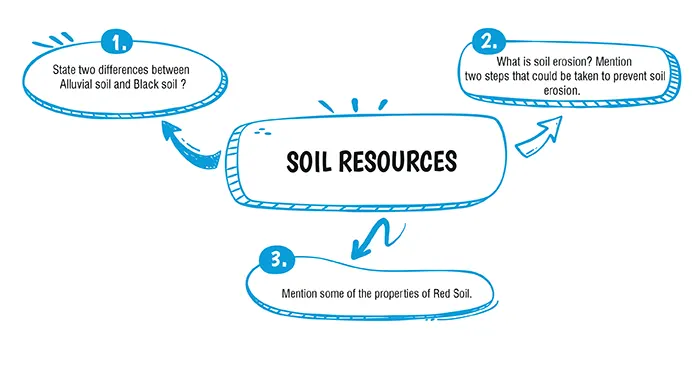Table of Contents

Ans. (C) Tropic of Cancer
Explanation:
Red Soil is red in colour because it contains a great proportion of ferric-oxides.
Ans. (C) Himalayas
Explanation:
Black soil is also called as regur soil or black cotton soil. It is the third major group of soil in India and forms the top part of the earth’s surface.
Explanation:
| Alluvial Soil | Black Soil |
|---|---|
| 1. Originated from the transported alluvium brought by the rivers. | Originated from the solidification of basic lava, spread over large areas of Deccan Plateau during volcanic activity. |
| 2. Rich in potash and humus but deficient in phosphorus and nitrogen. | Rich in lime, alumina, iron, potash, magnesium carbonate and calcium and deficient in potash, nitrogen and humus. |
Explanation:
Removal or destruction of top soil by the agents like winds and running water is called soil erosion.
1. Afforestation : The best way to prevent soil erosion is to increase area under forests.
2. Constructing dams and barrages : Soil erosion by flood can be checked by constructing dams or barrages over the rivers. This checks the speed of water thereby saving soil from erosion.
Explanation:
(i) Red Soil is formed in situ by weathering of the ancient crystalline and metamorphic rocks.
(ii) It is rich in iron content, hence, it is red in colour.
(iii) Its productivity increases with regular use of fertilisers.
(iv) It is porous in nature but not retentive to moisture.
(v) It is suitable for dry farming as it does not require much moisture.
Download Mind Map of this chapter
Download NowWant to Practice Mock Tests of this chapter
Practice NowDownload Important Questions of this chapter
Download Now| Chapter No. | Chapter Name |
|---|---|
| Chapter 1 | Map Study: Interpretation of Topographical Maps |
| Chapter 2 | Map of India |
| Chapter 3 | Location, Extent and Physical features |
| Chapter 4 | Climate of India |
| Chapter 5 | Soil Resources |
| Chapter 6 | Natural Vegetation of India |
| Chapter 7 | Water Resources |
| Chapter 8 | Mineral and Energy Resources |
| Chapter 9 | Agriculture In India |
| Chapter 10 | Industries in India: Agro Based |
| Chapter 11 | Industries in India: Mineral Based |
| Chapter 12 | Transport in India |
| Chapter 13 | Waste Generation and Management |
CBSE Important Questions Class 10
ICSE Important Questions Class 10
CBSE Important Questions Class 10
ICSE Important Questions Class 10